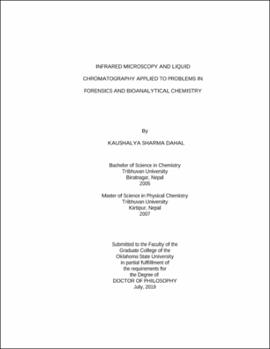| dc.contributor.advisor | Lavine, Barry K. | |
| dc.contributor.author | Sharma Dahal, Kaushalya | |
| dc.date.accessioned | 2021-04-06T16:06:38Z | |
| dc.date.available | 2021-04-06T16:06:38Z | |
| dc.date.issued | 2019-07 | |
| dc.identifier.uri | https://hdl.handle.net/11244/329103 | |
| dc.description.abstract | The main objectives of the research described in this dissertation are: (1) development of a methodology to prepare thin sections of automotive paint samples that involve exposing the edge of the sample using a microtome for infrared image analysis, (2) implementation of infrared library searching to match attenuated total reflection spectra obtained from an IR microscope to a transmission infrared spectral library, and (3) development of a reversed phase liquid chromatographic method to simultaneously detect renal cell carcinoma cancer biomarkers in urine. In one study, infrared imaging microscopy was investigated as a potential method to improve both the speed and accuracy of forensic automotive paint analysis. This is achieved by scanning across the layers of a paint sample using an infrared imaging microscope followed by decatenation of the image using alternating least squares. This approach, not only eliminates the need to hand section and analyze each paint layer separately, but also ensures that the IR spectrum of each layer is "pure" and not a mixture as a result of sampling too to the boundary between two paint layers a scalpel is used to hand section a paint chip to separate the individual layers. In a second study, an isocratic reversed phase liquid chromatographic method was developed to simultaneously detect and quantify three potential renal cell carcinoma biomarkers in urine which are present at relatively high concentrations: quinolinic acid, gentisic acid and 4-hydroxybenzoic acid. Using a methanol or butanol in water mobile phase with 0.6% acetic acid and a Zorbax C18 column, baseline resolution for creatinine and the three biomarkers in synthetic urine was achieved when water rich mobile phases were used. Detection of creatinine and the three biomarkers in urine using the proposed method was limited by background from the urine matrix for the later eluting compounds and from the dead marker for the earlier eluting compounds. | |
| dc.format | application/pdf | |
| dc.language | en_US | |
| dc.rights | Copyright is held by the author who has granted the Oklahoma State University Library the non-exclusive right to share this material in its institutional repository. Contact Digital Library Services at lib-dls@okstate.edu or 405-744-9161 for the permission policy on the use, reproduction or distribution of this material. | |
| dc.title | Infrared microscopy and liquid chromatography applied to problems in forensics and bioanalytical chemistry | |
| dc.contributor.committeeMember | El Rassi, Ziad | |
| dc.contributor.committeeMember | Materer, Nicolas | |
| dc.contributor.committeeMember | Bunce, Richard | |
| dc.contributor.committeeMember | Mintmire, John | |
| osu.filename | SharmaDahal_okstate_0664D_16391.pdf | |
| osu.accesstype | Open Access | |
| dc.type.genre | Dissertation | |
| dc.type.material | Text | |
| dc.subject.keywords | automotive paint | |
| dc.subject.keywords | chemometrics | |
| dc.subject.keywords | forensic analysis | |
| dc.subject.keywords | ir microscope | |
| dc.subject.keywords | renal cell carcinoma | |
| dc.subject.keywords | water-rich mobile phase | |
| thesis.degree.discipline | Chemistry | |
| thesis.degree.grantor | Oklahoma State University | |
